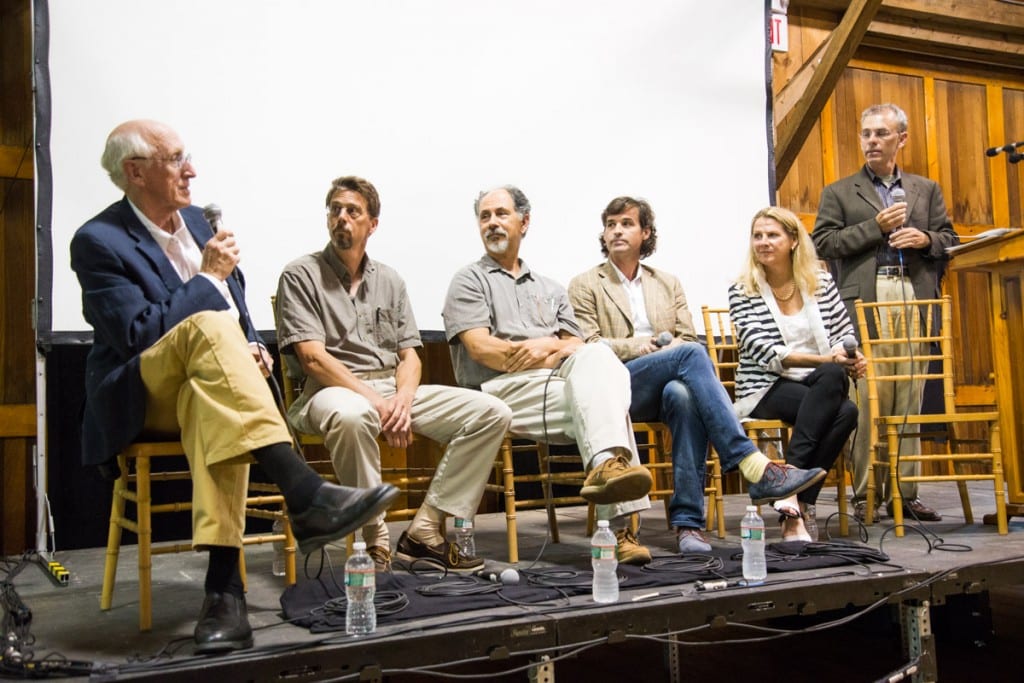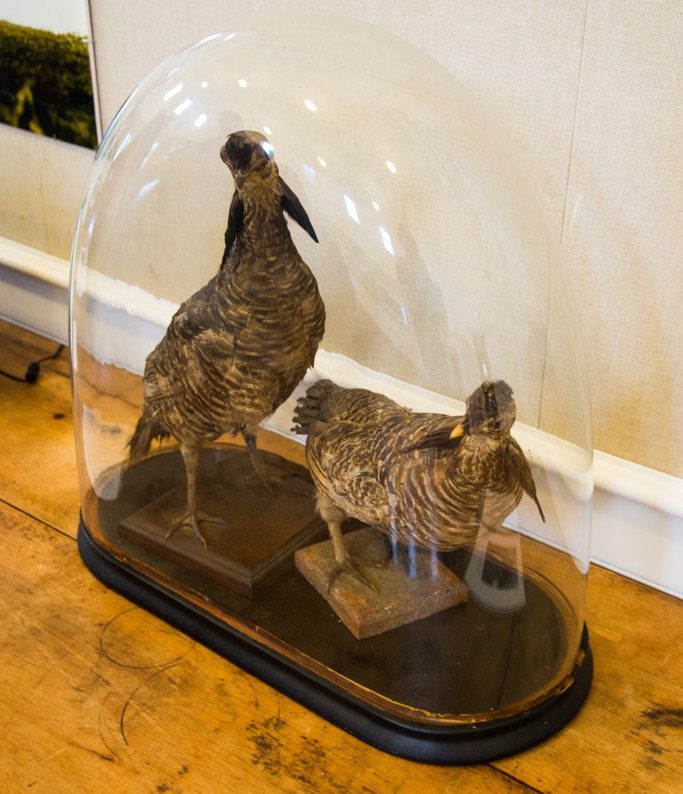Event Report:
The Heath Hen
Could Come Back
By Stewart Brand
Held on Martha’s Vineyard, July 24, 2014
Heath Hens were wild chickens once abundant throughout New England, but they were so tasty and easy to shoot that they were hunted to extinction on the mainland by 1870. One last flock survived on Martha’s Vineyard for 60 years because Islanders invented the form of conservation known as habitat preservation. What is now the State Forest was originally set aside and protected as Heath Hen habitat, and the birds were defended against hunters and predators.
In the 1920s the Island became famous for its beloved but dwindling flock, and when the last one, known as “Booming Ben,” died in 1932, the sense of tragedy was widespread. In the Vineyard Gazette Henry Beetle Hough wrote an editorial that became the definitive statement about extinction:
There is no survivor, there is no future, there is no life to be recreated in this form again. We are looking upon the uttermost finality which can be written, glimpsing the darkness which will not know another ray of light. We are in touch with the reality of extinction.
That last chapter in the Heath Hen saga helped set in motion the conservation movement of the 20th century.
Renewed Hope for the Heath Hen
But what if it is not the last chapter, and Martha’s Vineyard can take up the story where it left off and demonstrate a revolutionary new set of goals and tools for conservation?
Thanks to recent and still-emerging breakthroughs in genetic technology, we told the Islanders, it is becoming possible the bring the extinct Heath Hen back to life. Its genome can be completely reassembled from DNA still in the 100+ museum specimens. The unique genes of the subspecies can be edited into the genome of its closest living relative, the Prairie Chicken, effectively resurrecting the Heath Hen via a sort of one-directional hybridization.
It is possible, for technical reasons, that the Heath Hen could be the first animal brought back from extinction. (The Heath Hen and Prairie Chicken are so closely related that genome comparison, gene transfer, and surrogate parenting could be relatively simple; also the genome of the domestic chicken has been thoroughly studied, which will make all the genome analysis quicker and more certain.)
On July 24, 2014 Revive & Restore organized an evening panel event at the Ag Hall, titled “The Heath Hen Could Come Back.” Panelists included Islanders Tom Chase, Matt Pelikan, and Tom Dunlop, along with island conservationist Josh Donlan and the co-founders of Revive & Restore, Stewart Brand and Ryan Phelan. The audience of 175 was enthusiastic, and a report in the Vineyard Gazette, “Heath Debate Contains Vineyard DNA,” gave a thorough account of the evening.
 Pictured L to R: Stewart Brand, Matt Pelikan, Tom Chase, Josh Donlan, Ryan Phelan and Tom Dunlop. Photo credit: Ray Ewing
Pictured L to R: Stewart Brand, Matt Pelikan, Tom Chase, Josh Donlan, Ryan Phelan and Tom Dunlop. Photo credit: Ray Ewing
The conservationists on the panel suggested that the ambitious vision of bringing back the Island’s most famous bird and its former shrubland/grassland habitat could inspire efforts to restore much of the Island’s wildlands to their original more biodiverse condition, reducing some of the current overgrowth of forest with prescribed fire and other techniques. Also the Island’s excess of meso-predators (skunks, raccoons, and feral cats) could be reduced to a more natural level. Among the co-beneficiaries would be many birds, mammals, and flowers now seldom seen.
Two of the postdocs on the Mammoth Revivalist team —Justin Quinn and Margo Monroe—brought their enthusiasm from the Wyss Institute at Harvard Medical School in Boston.
A supportive editorial in the Vineyard Gazette, “What Would Henry Do?” concluded:
And as Henry Beetle Hough understood, a small bird with a booming voice can be a compelling symbol of something larger than itself.
Immediately following the editorial was a letter from Stephen Kellert, a Yale professor emeritus and former co-author with E.O. Wilson of “The Biophilia Hypothesis.” He wrote:
I was privileged last night, along with many others, to listen to the remarkably intelligent, informative and persuasive remarks of six panelists speaking about the possible “rebirth” of an extinct subspecies, the heathhen, a bird once so abundant colonial indentured servants refused to work if fed the birds too often…. Restoring the heathhen offers us the chance for a moral reawakening. It provides us with an affirmative opportunity to restore our connection to the earth and contribute to the healing and beauty of the land. It provides us with the chance to engage our relation to the world beyond ourselves of which we are a part. It offers Martha’s Vineyard the extraordinary opportunity to lead as an inspiring example to America of how by living in right relation to nature we may flourish and achieve an ineffable and deepening connection to the larger community of life.
Thoughtful Island Community
Is Good Fit for Heath Hen
By Susan Johnson Banta
Vineyard Gazette Editorial
AUGUST 7, 2014
On Thursday, July 24, the Island was presented with the opportunity to discuss bringing back the heath hen at a community meeting at the Agricultural Hall in West Tisbury. The idea that sparked that event came from the simple mention of the iconic bird at a picnic about a year ago, almost to the day. Since then the community of Martha’s Vineyard has taken me on an eye-opening journey, talking to so many Islanders I had not previously met.
My goal in this project has been to engage the community in a conversation. Until the Ag Hall event, my position on this subject was genuinely neutral within the contextual guideline of do no harm to the Vineyard. Whether or not a heath hen ever sets foot on the Vineyard again, I championed the idea because there were so many benefits to be gained in just attempting to undertake this huge project. Most of those benefits I learned about over the course of a four-day visit to the Island in late March with Stewart Brand and Ryan Phelan, the creators of Revive & Restore, a conservation-based project of The Long Now Foundation that is dedicated to long-term thinking and problem solving. The highlight of our visit was an informal, creative brainstorming roundtable at the Martha’s Vineyard Museum with many of the Island leaders and stakeholders. The question was posed: How could the Vineyard benefit from bringing back the heath hen? The list was long and varied with benefits ranging from dialing down the predators to opening view corridors, to building new affordable housing, to the potential of creating a regional bio-tech institute on the Vineyard, to bringing back the bobwhite quail. But perhaps the greatest benefit of all is that the discussion around this extinct bird provided an invitation to the Island people and conservation groups to come together and ask themselves, what do they want their Island to be in the future, 10 years from now, 20, 50, or 100? And how can we work together to get there?
We had a couple of working titles for the Agricultural Hall heath hen event over the course of the past year that clearly reflected our changing position. Heath Hen Homecoming, our first attempt, we soon realized was too presumptuous. The heath hen would never come back unless the Vineyard wanted to create a homecoming of its own. That was something we hoped the Agricultural Hall community meeting would help determine. Next came Save the Heath Hen, which I championed as I worked with the library, museum and schools on both the exhibit of the history of the heath hen and on the curricula outline for a high school examination of the sociological, biological, ecological and historical perspectives of this question. Elliott Bennet, chairman of the science department at the high school, shared the curricula I wrote with all her high school science teachers. Then this past spring each teacher and student either selected a section for critical study or was inspired to create their own angle. I interpreted saving the heath hen to mean the memory as well as potentially the species. But eventually we settled on The Heath Hen Could Come Back, proposed by Stewart Brand. I came to agree that it voices our intention best. It expresses an opportunity to be developed or not by the community, to become the first community on earth to re-introduce an extinct species.
Despite a lot of hard work over the past year, and a lot of support from many enthusiastic Islanders, I remained neutral on the subject. Even bringing back a virtual heath hen would have its benefits, I thought. But as the lights began to dim that Thursday evening at the Ag Hall and the room began to fill with 175 residents from around the Island, an image from the event poster filled the screen and I sat there in silence for a few moments just looking at this majestic pair of beautifully-arrayed heath hens. For the first time in a year, I became really present with this bird whose large image now loomed over us. And though I had asked myself and many others, this moment was the first time I silently asked the bird, what do you think? Is this a good thing? Do you want to come back? Sounds a little nutty, but I have always trusted my intuition in business and life. So I can confidently tell you, I strongly sensed that yes, this species wants to come back.

Pictured above: Heath Hen specimens on display at the Heath Hen Could Come Back community event, courtesy of the Martha’s Vineyard Museum. The Museum and the Vineyard Gazette put together a special exhibit for this event on the history of the heath hen and the extraordinary effort the Islanders’ made trying to save the species.
I sincerely hope someone steps up from the Island to become the steward and leader of this project. The Island and the heath hens are lucky to have the attention of Mr. Brand and Ms. Phelan, pioneers at the frontier of cultural re-imagination, who have access to the scientific resources to work with you on this cutting edge proposition.
While hanging the event posters around the Island, I had many conversations with shopkeepers, gas station attendants, fishermen, artists, educators, churchgoers, farmers, chefs and religious leaders. With deep gratitude I thank them for their support and open mindedness. And here’s an extra shout out to the Islanders, whatever position they may hold on this subject. I am filled with gratitude that they listened to what first sounded like a crazy idea. Thank you for offering your counsel, your time, your encouragement, your courage, your address book, your enthusiasm, your ideas, and your criticism. Critical thinking will bring us to the best place. Special thanks to the many Island people who welcomed us, showed enthusiasm for our thinking and helped make the event happen, a list too long for this space.
And many thanks to all those Islanders who attended the Chilmark library seminar of Wednesday night and the Agricultural Hall event on Thursday to learn about this unique concept. I am proud to have held a long-term relationship with an Island that must have one of the highest concentrations of thoughtful and creative people in the world. If this will happen anywhere, which eventually it will, I think it has its best shot with our community.
Susan Johnson Banta is community development consultant on the heath hen project for Revive & Restore. She lives in Chilmark, Massachusetts and Stinson Beach, California.





